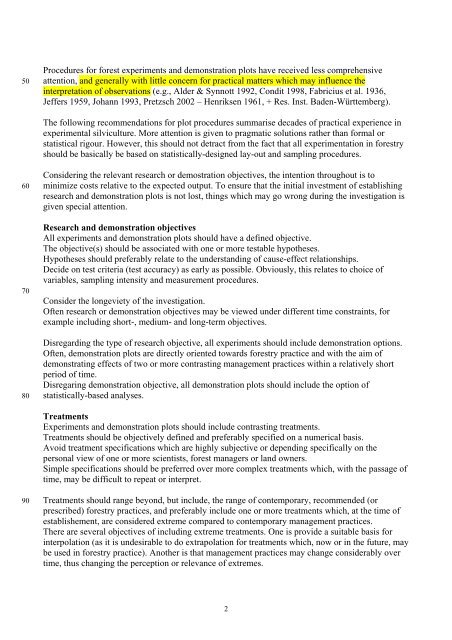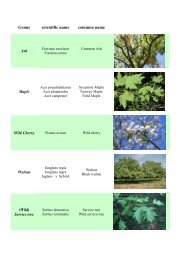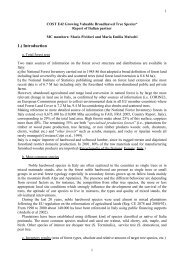Procedures for forest experiments and demonstration plots - Valbro
Procedures for forest experiments and demonstration plots - Valbro
Procedures for forest experiments and demonstration plots - Valbro
You also want an ePaper? Increase the reach of your titles
YUMPU automatically turns print PDFs into web optimized ePapers that Google loves.
50<br />
60<br />
70<br />
80<br />
90<br />
<strong>Procedures</strong> <strong>for</strong> <strong>for</strong>est <strong>experiments</strong> <strong>and</strong> <strong>demonstration</strong> <strong>plots</strong> have received less comprehensive<br />
attention, <strong>and</strong> generally with little concern <strong>for</strong> practical matters which may influence the<br />
interpretation of observations (e.g., Alder & Synnott 1992, Condit 1998, Fabricius et al. 1936,<br />
Jeffers 1959, Johann 1993, Pretzsch 2002 – Henriksen 1961, + Res. Inst. Baden-Württemberg).<br />
The following recommendations <strong>for</strong> plot procedures summarise decades of practical experience in<br />
experimental silviculture. More attention is given to pragmatic solutions rather than <strong>for</strong>mal or<br />
statistical rigour. However, this should not detract from the fact that all experimentation in <strong>for</strong>estry<br />
should be basically be based on statistically-designed lay-out <strong>and</strong> sampling procedures.<br />
Considering the relevant research or demostration objectives, the intention throughout is to<br />
minimize costs relative to the expected output. To ensure that the initial investment of establishing<br />
research <strong>and</strong> <strong>demonstration</strong> <strong>plots</strong> is not lost, things which may go wrong during the investigation is<br />
given special attention.<br />
Research <strong>and</strong> <strong>demonstration</strong> objectives<br />
All <strong>experiments</strong> <strong>and</strong> <strong>demonstration</strong> <strong>plots</strong> should have a defined objective.<br />
The objective(s) should be associated with one or more testable hypotheses.<br />
Hypotheses should preferably relate to the underst<strong>and</strong>ing of cause-effect relationships.<br />
Decide on test criteria (test accuracy) as early as possible. Obviously, this relates to choice of<br />
variables, sampling intensity <strong>and</strong> measurement procedures.<br />
Consider the longeviety of the investigation.<br />
Often research or <strong>demonstration</strong> objectives may be viewed under different time constraints, <strong>for</strong><br />
example including short-, medium- <strong>and</strong> long-term objectives.<br />
Disregarding the type of research objective, all <strong>experiments</strong> should include <strong>demonstration</strong> options.<br />
Often, <strong>demonstration</strong> <strong>plots</strong> are directly oriented towards <strong>for</strong>estry practice <strong>and</strong> with the aim of<br />
demonstrating effects of two or more contrasting management practices within a relatively short<br />
period of time.<br />
Disregaring <strong>demonstration</strong> objective, all <strong>demonstration</strong> <strong>plots</strong> should include the option of<br />
statistically-based analyses.<br />
Treatments<br />
Experiments <strong>and</strong> <strong>demonstration</strong> <strong>plots</strong> should include contrasting treatments.<br />
Treatments should be objectively defined <strong>and</strong> preferably specified on a numerical basis.<br />
Avoid treatment specifications which are highly subjective or depending specifically on the<br />
personal view of one or more scientists, <strong>for</strong>est managers or l<strong>and</strong> owners.<br />
Simple specifications should be preferred over more complex treatments which, with the passage of<br />
time, may be difficult to repeat or interpret.<br />
Treatments should range beyond, but include, the range of contemporary, recommended (or<br />
prescribed) <strong>for</strong>estry practices, <strong>and</strong> preferably include one or more treatments which, at the time of<br />
establishement, are considered extreme compared to contemporary management practices.<br />
There are several objectives of including extreme treatments. One is provide a suitable basis <strong>for</strong><br />
interpolation (as it is undesirable to do extrapolation <strong>for</strong> treatments which, now or in the future, may<br />
be used in <strong>for</strong>estry practice). Another is that management practices may change considerably over<br />
time, thus changing the perception or relevance of extremes.<br />
2







